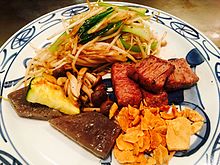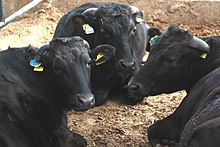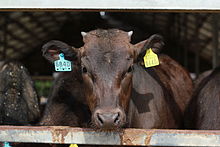Is Kobe Beef Cheap in Japan


Kobe beef repast served in a steakhouse in Kobe
Kobe beef ( 神戸ビーフ , Kōbe bīfu ) is Wagyu beef from the Tajima strain of Japanese Black cattle, raised in Japan'due south Hyōgo Prefecture according to rules set out by the Kobe Beefiness Marketing and Distribution Promotion Clan.[1] The meat is a delicacy, valued for its flavor, tenderness, and fatty, well-marbled texture. Kobe beef can be prepared as steak, sukiyaki, shabu-shabu, sashimi, and teppanyaki. Kobe beef is mostly considered one of the three top brands (known equally Sandai Wagyu, "the three big beefs"), along with Matsusaka beef and Ōmi beef or Yonezawa beef.
Kobe beef is likewise called Kōbe-niku ( 神戸肉 , "Kobe meat"), Kōbe-gyū or Kōbe-ushi ( 神戸牛 , "Kobe cattle") in Japanese.[1]
History [edit]

Tajima cattle on a Hyōgo farm

Tajima cattle on a Hyōgo farm
Cattle were brought to Nihon from Prc in almost the second century AD, in the Yayoi menstruum.[2] : 209
Until about the time of the Meiji Restoration in 1868, they were used only equally draught animals, in agriculture, forestry, mining and for ship, and as a source of fertiliser.
Milk consumption was unknown, and – for cultural and religious reasons – meat was not eaten.[3] : two [4] [five]
Japan was effectively isolated from the rest of the earth from 1635 until 1854; there was no possibility of intromission of foreign genes to the cattle population during this fourth dimension.
Betwixt 1868, the twelvemonth of the Meiji Restoration, and 1887, some ii,600 strange cattle were imported, including Braunvieh, Shorthorn, and Devon.[3] : 8 [6]
Betwixt near 1900 and 1910 in that location was extensive cantankerous-breeding of these with native stock. From 1919, the diverse heterogeneous regional populations that resulted from this cursory period of cross-breeding were registered and selected as "Improved Japanese Cattle".
Four separate strains were characterized, based mainly on which type of strange cattle had near influenced the hybrids, and were recognized as breeds in 1944. These were the iv wagyū breeds, the Japanese Blackness, the Japanese Brown, the Japanese Polled and the Japanese Shorthorn.[3] : viii [6]
The Tajima is a strain of the Japanese Black, the most populous brood (effectually 90% of the four breeds).[7] [8]
Beef consumption remained depression until after Earth War II. Kobe beef grew in popularity and extended its global reach in the 1980s and 1990s.[ix]
In 1983, the Kobe Beef Marketing and Distribution Promotion Association was formed to ascertain and promote the Kobe trademark. It sets standards for animals to be labeled equally Kobe beefiness.[10]
In 2009, the USDA placed a ban on the import of all Japanese beef to prevent the Japan foot-and-mouth outbreak from reaching US shores. The ban was relaxed in August 2012 and thereafter Kobe beef was imported into the The states.[xi]
Industry [edit]

Hyōgo prefecture, where authentic Kobe beef is produced
Kobe beefiness in Japan is a registered trademark of the Kobe Beef Marketing and Distribution Promotion Clan ( 神戸肉流通推進協議会 , Kōbeniku Ryūtsū Suishin Kyōgikai ).[12] Information technology must fulfill all the following conditions:[1]
- Tajima cattle born in Hyōgo Prefecture
- Farm feeding in Hyōgo Prefecture
- Heifer (a female person that has not given birth) or Bullock (steer or castrated bull)
- Processed at slaughterhouses in Kobe, Nishinomiya, Sanda, Kakogawa, or Himeji in Hyōgo Prefecture
- Marbling ratio, called BMS, of level half dozen and above[13]
- Meat quality score of iv or 5,[13] yield grade A or B[6]
- Carcass weight of 499.9 kg or less.[6]
The cattle are fed on grain fodder and brushed sometimes for setting fur.[14] [15] The melting point of fatty of Kobe beef (Tajima cattle) is lower than common beef fat.[16]
Kobe beef is expensive, partly because but about 3,000 caput of cattle may qualify equally Kobe per yr.[6] In Nihon, all cattle, including those approved as Kobe beef, can be tracked via a 10-digit number through every step of their entire life bike.[17]
Outside Japan [edit]
Kobe beef was non exported until 2012.[ commendation needed ] Information technology was exported in Jan 2012 to Macau, and then to Hong Kong in July 2012.[18] Since then, exports have also been made to the United states of america, Singapore, Thailand,[nineteen] the U.k.[xx] and Canada.[21]
In some countries, including Canada, the Britain and the Us, Wagyu cattle imported from Japan are farmed, either purebred or cross-bred with other beef breeds such as Aberdeen Angus. In some places meat from these cattle may be marketed under names such every bit "Kobe-style beefiness"; it is not Kobe beef, and does not fulfil the requirements for certification of the authentic Japanese product.[22] [23] Due to a lack of legal recognition of the Kobe beef trademark in the United States, information technology is also possible to sell this meat every bit "Kobe beef".[24] [25] The Kobe Beef Marketing and Distribution Promotion Association planned to publish pamphlets almost Kobe beef in foreign languages.[26]
American "Kobe-style" beef tends to exist darker and stronger-tasting than the authentic product.[27] It may have more appeal to Western palates unfamiliar with the mild gustation and high fat content of true Kobe beefiness.[7]
Run across also [edit]
- Akaushi
- Geographical indication
- Matsusaka beef
- Mishima beef
- Yonezawa beef
- List of delicacies
References [edit]
- ^ a b c "Kobe Beef Marketing & Distribution Promotion Association Bylaws". Retrieved 30 September 2010.
- ^ Valerie Porter, Lawrence Alderson, Stephen J.G. Hall, D. Phillip Sponenberg (2016). Mason's World Encyclopedia of Livestock Breeds and Breeding (sixth edition). Wallingford: CABI. ISBN 9781780647944.
- ^ a b c Kiyoshi Namikawa (2016 [1992]). Breeding history of Japanese beef cattle and preservation of genetic resource equally economical farm animals. Kyoto: Wagyu Registry Association. Accessed January 2017.
- ^ Simone Baroke (viii August 2014). "Japanese Wagyu Beef – Too Accurate ?". Global Meat News.
- ^ Y., Grant (1 December 2008). "The Real Beefiness on Kobe Beef". Cheff Seattle.
- ^ a b c d due east Bennett, Steve. "History of Wagyu beefiness cattle brood in Nippon". www.wagyuinternational.com . Retrieved 15 December 2017.
- ^ a b Jim Vorel (24 Feb 2015). "Adventures in Beef: A First-Time Taste of Authentic Japanese Wagyu". Paste.
- ^ Longworth, John West. (28 October 2004). "The History of Kobe Beef in Japan". Lucies Subcontract: Meat Digest. Archived from the original on 11 August 2007. Retrieved 5 June 2007.
- ^ Meghan Staley. "Kobe Beef". Trade Environment Database. American University. Archived from the original on 28 March 2015.
- ^ Krieger, Daniel (26 Baronial 2010). "All for the honey of Tajima cows". Japan Times.
- ^ Olmsted, Larry (7 January 2014). "The New Truth About Kobe Beef". Forbes.
- ^ "Kobe Beef Registered Trademarks". Retrieved 30 September 2010.
- ^ a b "Japanese Meat Grading" (PDF). Archived from the original (PDF) on 21 Nov 2011. Retrieved 3 Baronial 2016.
- ^ Mail mag entitled Kobe Merumaga Guild ii June 2002 outcome by Kobe Urban center Office
- ^ "edition September 19, 2007 issue". News Calendar week Japanese. 19 September 2007. Archived from the original on 26 April 2009. Retrieved 16 March 2010.
- ^ Shin-Onsen town office. "Taste of Tajima-ushi" (in Japanese). Retrieved 6 September 2010.
- ^ Yoshihisa, Godo. "The Beef Traceability System in Japan". FFTC Agricultural Policy Platform . Retrieved 15 December 2017.
- ^ Jason Chow (27 July 2012). "Kobe Beef Arrives in Hong Kong". Wall Street Journal.
- ^ "Kobe Beef Marketing and Distribution Information".
- ^ Rayner, Jay (11 March 2018). "Farm Girl Café, Chelsea: 'We don't stay for dessert, because we have suffered enough' – eating house review". The Guardian . Retrieved 12 March 2018.
- ^ Sufrin, Jon (23 April 2015). "If you recall you've had Kobe beefiness in Canada, you lot're incorrect. Only hither's your take a chance". The Earth and Mail.
- ^ "Cattle on 40 pints a solar day of beer". BBC News. nine February 2007.
- ^ J.C. Reid (thirteen March 2015). "American Wagyu and the myth of Kobe beef". Houston Chronicle.
- ^ Olmstead, Larry (12 Apr 2012). "Food's Biggest Scam: The Bang-up Kobe Beef Lie". Forbes.
- ^ Olmstead, Larry (7 Jan 2014). "Nutrient's Biggest Scam, Part ii: "Domestic" Kobe And Wagyu Beef". Forbes.
- ^ Yomiuri Shimbun (xix July 2008). "Kobe beef — Correct information for foreign countries" (in Japanese). Archived from the original on eighteen October 2008. Retrieved 20 July 2008.
- ^ Sayet, Jackie (6 October 2009). "Bogus beef: Miami restaurants say it'south Kobe, but information technology's not". Miami New Times.
External links [edit]
| | Wikimedia Commons has media related to Kobe beefiness. |
- Kobe Beef Marketing & Distribution Promotion Clan
williamshistiogge.blogspot.com
Source: https://en.wikipedia.org/wiki/Kobe_beef
0 Response to "Is Kobe Beef Cheap in Japan"
Post a Comment